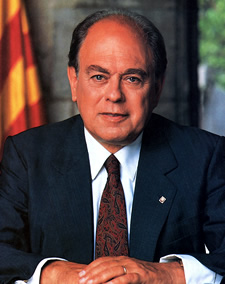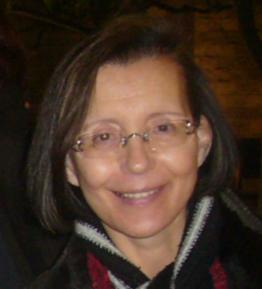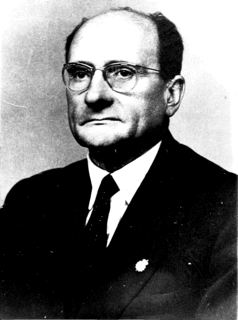
Catalan Countries refers to those territories where the Catalan language, or a variant of it, is spoken. They include the Spanish regions of Catalonia, Valencia, the Balearic Islands and parts of Aragon and Murcia, as well as Roussillon in France, the Principality of Andorra, and the city of Alghero in Sardinia (Italy). In the context of Catalan nationalism, the term is sometimes used in a more restricted way to refer to just Catalonia, Valencia and the Balearic Islands. The Catalan Countries do not correspond to any present or past political or administrative unit, though most of the area belonged to the Crown of Aragon in the Middle Ages. Parts of Valencia (Spanish) and Catalonia (Occitan) are not Catalan-speaking.
The Republican Left of Catalonia is a Catalan nationalist and social democratic political party in the Spanish autonomous community of Catalonia. It is also the main sponsor of the independence movement from France and Spain in the territories known among Catalan nationalists as Països Catalans. Occitan Republican Left, formed in 2008, acts as the Aranese section of the party.

Jordi Pujol i Soley is a Spanish politician who was the leader of the party Convergència Democràtica de Catalunya (CDC) from 1974 to 2003, and President of the Generalitat de Catalunya from 1980 to 2003.

The Estelada is an unofficial flag typically flown by Catalan independence supporters to express their support for either an independent Catalonia or independent Països Catalans. The use of this flag as a protest symbol within Catalan nationalism has become more notable since the 1970s' Spanish transition to democracy.
The design of the Estelada comprises the red-and-yellow bars of the Senyera, with the addition of a five-pointed star in a triangle at the hoist. It wasn't adopted as the national flag of the proclaimed Catalan Republic (2017), the legitimacy of which was disputed; instead the Senyera flag was used.
Regionalist League of Catalonia was a right wing political party of Catalonia, Spain. It had a Catalanist, conservative, and monarchic ideology. Notable members of the party were Enric Prat de la Riba, Francesc Cambó, Agustí Riera i Pau, Joan Ventosa and Ramon d'Abadal i Calderó.

Josep Carner i Puigoriol, was a Catalan poet, journalist, playwright and translator. He was also known as the Prince of Catalan Poets.
He was nominated for the Nobel Prize in Literature seven times.

Montserrat Tura is a Spanish politician and Member of the Parliament of Catalonia. From 29 November 2006 to 29 December 2010, she had served as Minister of Justice of Catalonia. She is considered as one of the most prominent members of the Catalanist wing of the Socialists' Party of Catalonia. She is married with two daughters.

Santa Maria de Montserrat is an abbey of the Order of Saint Benedict located on the mountain of Montserrat in Monistrol de Montserrat, Catalonia, Spain. It is notable for enshrining the image of the Virgin of Montserrat. The monastery was founded in the 11th century and rebuilt between 19th and 20th centuries, and still functions to this day, with over 70 monks. There have always been roughly 80 monks in residence.

The national symbols of Catalonia are flags, icons or cultural expressions that are emblematic, representative or otherwise characteristic of Catalonia or Catalan culture.

La Garriga is a municipality in the province of Barcelona and autonomous community of Catalonia, Spain. The municipality covers an area of 18.8 square kilometres (7.3 sq mi) and the population in 2014 was 15,762.

The Assemblea Nacional Catalana is an organization that seeks the political independence of Catalonia from Spain. Secondarily, it also promotes the reunification of the Catalan Countries.
Pere Puig Subinyà was a Catalan politician and businessman. He was a member of Unió de Rabassaires and Republican Left of Catalonia

The Catalan Way, also known as the Catalan Way towards Independence, was a 400-kilometre (250 mi) human chain in support of Catalan independence from Spain. It was organized by the Assemblea Nacional Catalana (ANC), and took place in Catalonia on 11 September 2013, which is the National Day of Catalonia. Catalonia's Department of the Interior estimated the number of participants at about 1.6 million. The protest was supported by 14 nongovernmental groups The human chain followed the ancient Via Augusta, from Le Perthus up to Alcanar. According to Carme Forcadell, president of the ANC, it was "a symbol of the unity of Catalan people to achieve national sovereignty".
Committee Pro Catalonia was a Catalan political committee founded on July 8, 1918 to support the actions of the Catalan National Committee in Paris to achieve an official Catalan representation in the League of Nations. It was chaired by Vicenç Albert Ballester and Pere Oliver i Domenge with Francesc Macià, Manuel Folguera i Duran, J. Grant i Sala as leading participants. It counted with the support of Unió Catalanista party, and maintained contacts with members of the Lliga Regionalista. Most of its members integrated into the Federació Democràtica Nacionalista, and later on into the Estat Català party.

Maurici de Sivatte i de Bobadilla (1901–1980) was a Spanish Carlist politician. He is known as leader of Catalan Carlism in two separate strings, briefly in the early 1930s and then in the decade of the 1940s. He is also recognized as the moving spirit behind RENACE, a Traditionalist splinter faction set up in 1958.
Vicenç Albert Ballester i Camps was a Spanish politician, Catalan nationalist, considered by some to be the designer and promoter of the "estelada", Catalonia's independence flag.

Francoism in Catalonia was established between 1939 and 1977, following the Spanish Civil War and post-war Francoist repression. Francisco Franco's regime replaced Revolutionary Catalonia after the Catalonia Offensive at the end of the war. The dictatorship in Catalonia complemented the suppression of democratic freedoms with the repression of Catalan culture. Its totalitarian character and its unifying objectives meant the imposition of a single culture and a single language, Castillian. The regime was specifically anti-Catalan, but this did not stop the development of a Catalan Francoism that was forged during the war and fed by victory.
Daniel Cardona i Civit (1890–1943) was a Catalan politician, a prominent figure of 20th century radical Catalan separatism.
The People's Army of Catalonia was an army created by the Generalitat of Catalonia on December 6, 1936, during the Spanish Civil War. Its existence was more theoretical than real, because the original structure of the popular militias continued to exist despite the efforts of the Generalitat.












